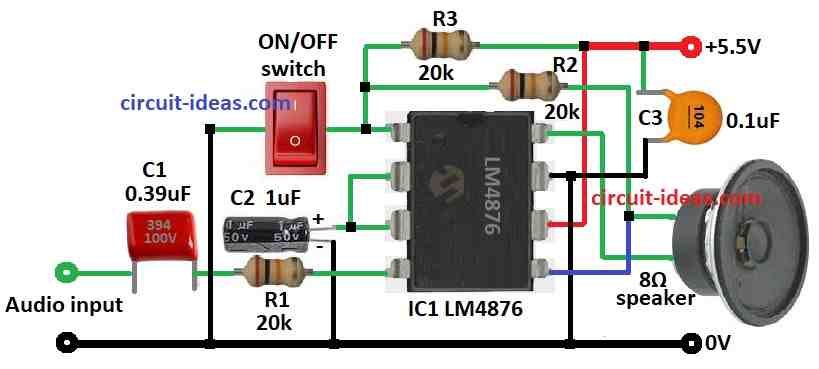An 5V audio amplifier circuit that is bridge tied is made using the IC LM4876.
This kind of circuit increases the audio signals volume for uses such as powering a portable devices speaker.
It might be difficult to build a compact amplifier for portable devices since they require minimal power.
The LM4876 chip from texas instruments is used in this design to produce a 1 watt audio amplifier.
Because it switches on and off with a basic logic signal and consumes very little current, this chip is perfect for portable electronics and low voltage audio systems.
Circuit Working:

Parts List:
| Category | Description | Quantity |
|---|---|---|
| Resistors | 20k | 3 |
| Capacitors | PPC 0.39μF 100V | 1 |
| Ceramic 0.1μF | 1 | |
| Electrolytic 1μF 25V | 1 | |
| Semiconductors | IC LM4876 | 1 |
| 8Ω speaker | 1 | |
| ON/OFF switch | 1 |
The circuit is minimal since the LM4876 only needs a few more parts and is packaged in a small 8 pin box.
Via a resistor R1 and capacitor C1, the audio signal enters the negative input pin 4 (-IN).
To regulate the gain of the amplifier, a second resistor R2 forms a feedback loop.
The amplifier may be turned on and off using a switch that is attached to the shutdown pin and pulls up resistor R3.
The two output pin 5 (V01) and pin 8 (V02) are connected to the speaker 8 ohms.
Because of its special internal circuitry, this chip may function in bridge mode, which doubles the speakers potential output power by operating the two internal amplifiers with a 180 degree phase shift.
Formulas:
The following are important equations and factors to take into account while creating a 5V audio amplifier circuit using the LM4876 IC.
Gain Calculation (if input resistors are being used):
The LM4876 may be utilized with or without external resistors R1 and R2 that set the gain.
The formula may be used to get the gain (Av) if resistors are your preferred method of setting the gain.
Av = R2 / R1
where,
- The resistor R1 is what connects the LM4876 input pin to the input signal.
- The resistor that connects the LM4876 input pin to ground is repreented by R2.
Determine the LM4876s power dissipation and make sure it does not exceed safe working parameters. One way to estimate this is to:
Pdiss = (Vcc−Vout) × Iout
where,
- The supply voltage is +5.5V Vcc.
- The output voltage swing, which is usually close to Vcc, is represented by Vout.
- The output current that is sent to the speaker is called Iout.
Efficiency:
The amplifiers efficiency (η) may be calculated as:
η = Output Power / Total Power Consumption × 100%
where,
- Given that both the output load and supply voltage affect the LM4876s efficiency.
Note:
You should be able to construct and calculate the parameters for your 5V audio amplifier circuit utilizing the LM4876 IC with the use of these formula and considerations.
The LM4876 datasheet contains comprehensive specs and application notes, always refer to it.
How to Build:
To build a simple 5V audio amplifier circuit using IC LM4876 follow the below mentioned steps:
- Gather all the components mentioned in above diagram.
- Connect pin 1 of IC1 to ground through ON/OFF switch.
- Connect pin 2 to pin 3 of IC1.
- Connect pin 3of IC1 to positive end of the capacitor C2 and negative end to ground.
- Connect pin 4 of IC1 to audio input through resistor R1 and capacitor C1.
- Connect resistor R2 between pin 1 and pin 5 of IC1.
- Connect 8 ohm speaker across pin 5 and pin 8 of IC1.
- Connect pin 6 of IC1 to positive supply of 5.5V.
- Connect pin 7 of IC1 to ground.
- Connect pin 8 of IC1 to one end of speaker.
- Connect resistor R3 to positive supply of 5.5V through pin 1 of IC1.
- Connect capacitor C3 from positive supply to ground.
Safety Measure:
- As previously indicated, heat dissipation may make the LM4876 unsuitable for a rigorous 5V operation.
- Make sure the chip is properly heat sink particularly at lower voltages when it must work harder to provide the same amount of electricity.
- A metal part called a heat sink is used to remove heat from an integrated circuit and release it into the surrounding atmosphere.
Conclusion:
This simple 5V audio amplifier circuit using IC LM4876 is low voltage operation, low current consumption, and tiny size make it an excellent option for building a small and effective audio amplifier circuit in portable devices.
At lower voltages, such as 5V be aware of possible constraints on heat dissipation.
Leave a Reply